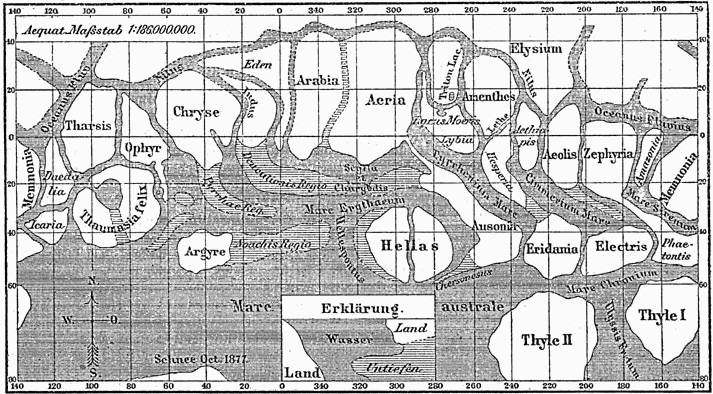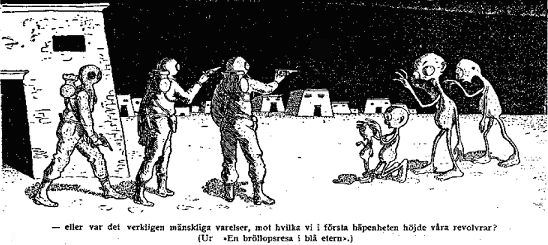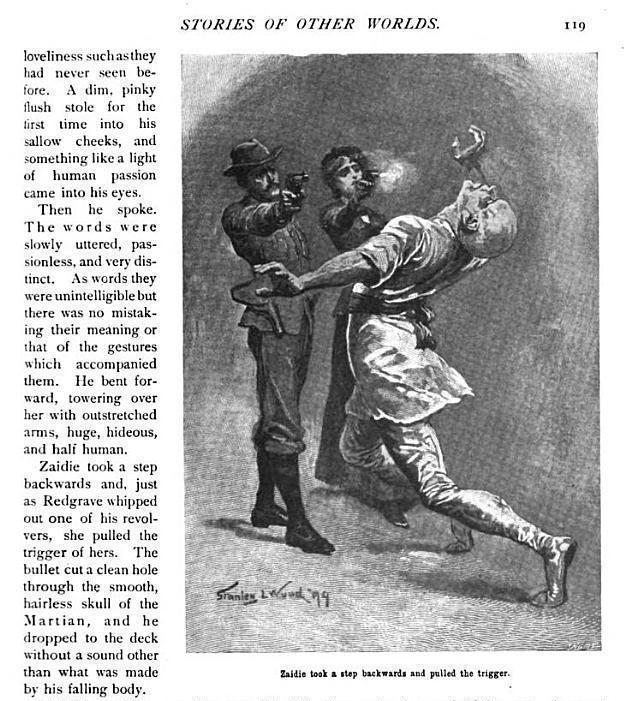
January 13, 2017, by Brigitte Nerlich
The mystery of the missing Martians
When the present is depressing and the future uncertain, it is sometimes nice to retreat to the past, especially to past futures. I recently tried to distract myself from the present by staring at Venus, Moon and Mars illuminating the evening sky. I then led my eyes wander around the internet and I inadvertently came across an image depicting Martians in a Swedish science fiction tale published in 1907 (see below under ‘missing Martian’).
I began to wonder when people first started to imagine the shape, form and colour of Martians. Following various trails on the internet, I found that numerous stories about Martians have been written, especially between the 1880s and the early 19th century – but, of course, stories about Mars (plus or minus imagined inhabitants) continue to be told; the latest one being The Martian.
I also discovered that these early stories were inspired by, or intersected in various ways with, stories and images told and produced by rather well-known writers, amongst them some of my favourites, such as Jules Verne (who surprisingly didn’t target Mars as an object for his stories) and Camille Flammarion. We should, of course, not forget H. G. Wells in the UK (sometimes called ‘the father of science fiction’) and Kurd Laßwitz in Germany (sometimes called the ‘father of German science fiction’ or ‘a German Jules Verne’) – and many more, as you can see in the ‘appendix’!
As with most of my blog posts, I waded into this topic without much expertise. If you want to know more, you should probably read Imaging Mars: A Literary History by Robert Crossley or Science Fiction the Early Years by Everett Franklin Bleiler and Richard Bleiler. My post relies mainly on on Bressan (2012), Dunn (2015), and Laskow (2016); and, of course Wikipedia.
In the following I’ll first provide some background to how Mars became a popular science topic. I’ll then home in on some of the early stories featuring Martians before coming to the curious illustration I mentioned at the beginning, which doesn’t seem to have made it into any of the overviews I consulted.
Making Mars public
It all began in the 17th century, when the Italian astronomer Francesco Fontana produced drawings of the surface of Mars in 1638. Some years later the Dutch astronomer Christiaan Huygens then created a first scientifically accurate map. At the end of the 18th century William Herschel, the first President of the Royal Astronomical Society, made accurate measurements of Mars’ rotation and much more. In the mid-19th century, the “French astronomer Camille Flammarion (1842-1925) analysed more than 2.600 drawings of Mars and published in 1876 a very detailed map, showing already two large oceans, 22 lakes, four sea channels and five continents. According to Flammarion, Earth and Mars were so similar, that a visitor would not notice substantial differences: ‘Rivers, glittering golden in their riverbed made of pebbles, creeks flowing through the plains or disappearing with waterfalls into valleys, large streams flowing slowly through the landscape to disappear into the sea.’” (Bressan, 2012)
In 1877 the Italian astronomer and science historian Giovanni Schiaparelli described what he called in Italian ‘canali’ on Mars, but insisted that “[i]t is not necessary to assume that it was the work of intelligent beings, and in spite of the geometric appearance of the whole system, we are inclined to believe that it originated during the evolution of the planet, just as on Earth the English Channel or the Channel of Mozambique.” (ibid.). However, he also speculated about life on Mars in La Vita sul Planeta Marte (1895).
In the same year, The American astronomer Percival Lowell published his book Mars, “which popularized the idea that Schiaparelli’s Martian channels ‘—now seen as engineered canals—were evidence [of] another intelligent civilization just 140 million miles or so away” (Laskow, 2015). In 1906 Lowell published Mars and Its Canals, followed in 1908 by Mars as the Abode of Life. His speculations probably lie behind a surge in ‘hype’ about Mars and its supposed inhabitants at the turn of the 19th and 20th century. However, they didn’t go unopposed. In 1907 the British naturalist Alfred Russel Wallace published a book Is Mars Habitable? which severely criticised Lowell’s claims” (Wikipedia). Click through and have a look!
Imagining/Imaging Martians
From around the 1860s onward sci-fi stories about Mars began to appear. You can find a list of them in the appendix. It would be great to go through all these books and look at the illustrations contained in them. For this blog post I could only grab a few that could find on the internet.
The best-known images of early Martians are related to H. G. Wells’ War of the Worlds published in 1898. This first edition doesn’t seem to have contained illustrations. However, the 1906 Belgian edition did. It was illustrated with 23 pen and ink drawings by Henrique Alvim Correa. The best known ones are of tentacled tripods attacking humans – we don’t see any Martians as such though. These only appear in in 1927 edition. The image corresponds to how Wells described the Martians, “as octopus-like creatures: the ‘body’ consisting of a disembodied head nearly four feet across, having two eyes; a v-shaped, beak-like mouth; and two branches each of eight ‘almost whip-like’ tentacles, grouped around the mouth, referred to as the ‘hands’”.
The same year, 1898, the American astronomer and writer Garrett P. Serviss published Edison’s Conquest of Mars. This was a sequel to Fighters from Mars, an unauthorized and heavily altered version of Well’s Wars of the Worlds (see Wikipedia). The Martians in this story are not like the squid-like Martians described there. Here we encounter huge google-eyed, goggle wearing creatures. We also find a Martian prisoner teaching earthlings the Martian language – sans goggles. The Conquest of Mars first appeared in serialised form in the New York Evening Journal with illustrations by P. Gray or by G.Y. Kauffman (I am not sure). The 1947 edition contained re-drawings by Bernard Manley.
To round off my foray into early images of Martians I now turn to my compatriot Laßwitz and his novel Auf zwei Planeten published in 1897. A later, 1948 edition, apparently contained 35 illustrations by Walter Zeeden which I’d love to see, but unfortunately I can only find a few. One of them is particularly interesting as it depicts a Martian solar energy plant!
Missing Martians
Surprisingly all my searching on the web hasn’t been able to unearth or unmars anybody really talking about the illustration which sparked my interest in the depiction of Martians in the first place!
This image illustrates an article by Carl Berg and Julius Regis entitled “En bröllopsresa i blå etern”, originally published in 1906/1907 – and just republished in 2016. The Swedish title of this story is normally translated as Honeymoon in Space, but should actually be translated as Honeymoon in the Blue Ether. Note the space suits and New Mexican landscape. In Document from Mars the heroes also deploy a “hidden weapon, ‘Strålvapnet’ (“The Ray Gun”), which wipes out any trace of a living creatures by pulverizing them to atoms and evaporating them (1910:22 p. 354 column 2)” (Hedman, p. 50).
I first came across this illustration when reading an article in Verniana by Dag Hedman, entitled “The influence of Jules Verne in Sweden around 1900” (2013; Swedish version here). “The article presents the impact of Jules Verne among Swedish readers around 1900 by investigating a juvenile magazine, Kamraten, published between 1892 and 1911. Two newly discovered Martian Epics in Kamraten by the Swedish author of adventure and crime stories, Julius Regis (1899-1925), ‘En bröllopsresa i blå etern’ (1906-7; ‘A Honeymoon in Space’) and ‘Dokumentet från Mars’ (1910; ‘The Document from Mars’), give vivid testimony to Verne’s popularly. These stories – in which Verne is mentioned – are about Swedes travelling in space and are clearly influenced by Verne’s novels” (Hedman, 2013: 43), such as Cinq semaines en ballon (1863), Voyage au centre de la terre (1864) and De la Terre a la Lune (1865; incidentally, the date when the first Mars story was published; see appendix). Kamraten was a magazine very similar to the older more well-established, Le Magasin d’éducation et de récréation, in France in which Jules Verne first started to publish his stories.
I won’t summarise the two Martian tales here, as you can read about them in Hedman’s article. I just want to quote how the Martians were described in The Document from Mars. The explorers meet “the ice people”, who are “cave-living humanoids, described as vile, reptilian, with ‘two thin legs and two thin arms and terrible clawlike fingers, saucerlike eyes and sectorial mouth’ (1910: 11/12, page 182, column 2)” (Hedman, 2013).
The illustration depicting the Martians can be found in A Honeymoon in the Blue Ether and has the following subtitle “- or were they really human beings, toward which we were aiming our revolvers in our initial astonishment?” (Kamraten, 1907: 20, p. 318). Interestingly, the illustrator of these stories is Ossian Elgström; in the story the two people on ‘honeymoon’ are Ossian Ström and his financée Karin Brander.
When I saw the title of the first story, namely Honeymoon in Space, I was reminded of yet another Martian tale (and one could explore a lot of ‘intertextuality’ between tales spun around the turn of the 19th to the 20th century!), namely Honeymoon in Space by Griffith published in 1901. I can’t see any similarities at the moment between the two stories. However, there is something interesting going on in the ‘other’ Honeymoon. As Wikipedia tells us: Griffith’s “science fiction depicted grand and unlikely voyages through our solar system in the spirit of Wells or Jules Verne, though his explorers donned space suits remarkably prescient in their design. Honeymoon in Space saw his newly married adventurers, exemplars of the ‘Race that Rules’, exploring planets in different stages of geological and Darwinian evolution on an educational odyssey drawing heavily on earlier cosmic voyages by Camille Flammarion, W. S. Lach-Szyrma, and Edgar Fawcett. Its illustrations by Stanley L. Wood have proved more significant, providing the first depictions of slender, super intelligent aliens with large, bald heads – the archetype of the famous Greys[citation needed] of modern science fiction.”
This seems to indicate that the illustrations for Griffith’s Honeymoon in Space don’t seem to have influenced Ossian Elgström’s depiction of Martians in Berg and Regis Honeymoon in the Blue Ether.
So I’ll end on a mystery. Why has nobody noticed ‘my’ missing Martians and why did Elgström represent his Martians as he did? Any ideas, readers?
Appendix: List of Martian adventures published between 1860 and 1910
(based on Wikipedia article on Mars in fiction with some of my own additions)
1865: Un habitant de la planète Mars (An inhabitant of the planet Mars) by French author Henri de Parville (1838-1909; and a friend of Camille Flammarion): “The biological conditions on Mars are very similar to Earth, there are mountains, oceans, continents and polar caps. Therefore it can be assumed that there are also beings, very similar to us humans, to be found.”
1880: Across the Zodiac by Percy Greg. The narrator flies his craft, the “Astronaut,” to visit diminutive beings on Mars.
1883: Wladislaw Lach-Szyrma began to imagine journeys around our solar system for Aleriel or a Voyage to other Worlds (1883)
1889: Uranie (translated as Urania in 1890) by Camille Flammarion. A young astronomer and his fiancée are killed in a ballooning accident, and are reincarnated in new bodies on Mars.
1889: Melbourne and Mars: My Mysterious Life on Two Planets by the Australian phrenologist and writer Joseph Fraser. A sick man named Jacobs starts having visions in his sleep, which turns out to be a telepathic link between him and a child called Charlie Frankston, his other self on Mars, who lives in a technological utopia.
1889: Mr. Stranger’s Sealed Packet by Hugh MacColl. People from Earth travel to Mars in a flying machine, and find peaceful Martians that are technologically inferior to humans with a few exceptions like voice-recording devices and electric lighting.
1890: A Plunge into Space (1890) by Robert Cromie. Dedicated to Jules Verne, the character Henry Barnett learns how to control the ethereal force which combines electricity and gravity and “which permeates all material things, all immaterial space”, and secretly builds a globular spaceship called the “Steel Globe”. Barnett and some friends travel to Mars and find a society where there is no need for politicians, and Martians who travel in airships or flying through levitation. This work predates H. G. Wells‘s The First Men in the Moon by some 10 years, but contains a number of similarities.
1892: Messages from Mars: By the Aid of the Telescope Plant the American musician and author Robert D. Braine – there are some similarities Well’s War of the Worlds; the Martians look very human
1893: Unveiling a Parallel by Alice Ilgenfritz Jones and Ella Merchant. The authors use a journey to Mars as the frame for a utopian feminist novel.
1894: Journey to Mars by the American physician and author Gustavus W. Pope. An adventure story that may have influenced Edgar Rice Burroughs‘s later books. There are red, blue and yellow Martians.
1896: A Prophetic Romance by John McCoy. Reversing the usual pattern, the book brings a Martian visitor to Earth for a utopian novel.
1897: Auf zwei Planeten by Kurd Laßwitz. A Martian expedition to Earth takes Earthmen back to visit Mars; interplanetary war follows the initially peaceful contact. Laßwitz’s Martians are human in appearance, but with much larger eyes.
1898: The War of the Worlds by H. G. Wells. Features an attack on England by cephalopod like Martians and their advanced technology to employ fighting machines to decimate the world.
1898: Edison’s Conquest of Mars by Garrett P. Serviss. In this Edisonade, Earthmen respond to an attack from Mars with a successful genocide of the Martian race. Martians are giant goggle-eyed creatures.
1899: A message from Mars: A fantastic comedy in three acts by UK playwright and author Richard Ganthony.
1901: A Honeymoon in Space by George Griffith. A young couple on a journey through the solar system are captured by hostile Martians. (fixup of series first published in Pearson’s Magazine as Stories of Other Worlds)
1903: A message from Mars – film version
1905: Gullivar of Mars by Edwin Lester Arnold. An Edwardian fantasy in which Gullivar Jones travels to Mars on a magic carpet and interacts with the slothful but innocent Hithers and the brutish but honorable Thithers.
1906: Doctor Omega by Arnould Galopin. A crew of explorers from Earth visit a Mars inhabited by reptilian mermen, savage dwarf-like beings with long, tentacled arms, bat-men and a race of civilized macrocephalic gnomes.
1906/07: En bröllopsresa i blå etern by Carl Berg and Julius Regis
1908: Le prisonnier de la planète Mars [Vampires of Mars] and its sequel La guerre des vampires [War of the Vampires] (1909) by Gustave Le Rouge. French engineer Robert Darvel is dispatched to Mars by the psychic powers of Hindu Brahmins. On the Red Planet, he runs afoul of hostile, bat-winged, blood-sucking natives, a once-powerful civilization now ruled by the Great Brain.
1908: Red Star (1908) by Alexander Bogdanov. The narrator is taken to Mars, which is imagined as a socialist utopia.
1908: Die Reise zum Mars by Hans Dominik parts of the story are similar to Laßwitz’ Auf Zwei Planeten. Laßwitz was a teacher at the high school in Gotha when Dominik went to school there.
1910: Dokumentet från Mars by Julius Regis.
And then they turned green! “the first use of the specific phrase ‘little green man’ in reference to extraterrestrials that Aubeck found dates to 1908 in the Daily Kennebec Journal (Augusta, Maine), in this case the aliens again being Martians.” (wikipedia)
Image: Historische Karte der Marsoberfläche nach Giovanni Schiaparelli (1877)
No comments yet, fill out a comment to be the first




Leave a Reply